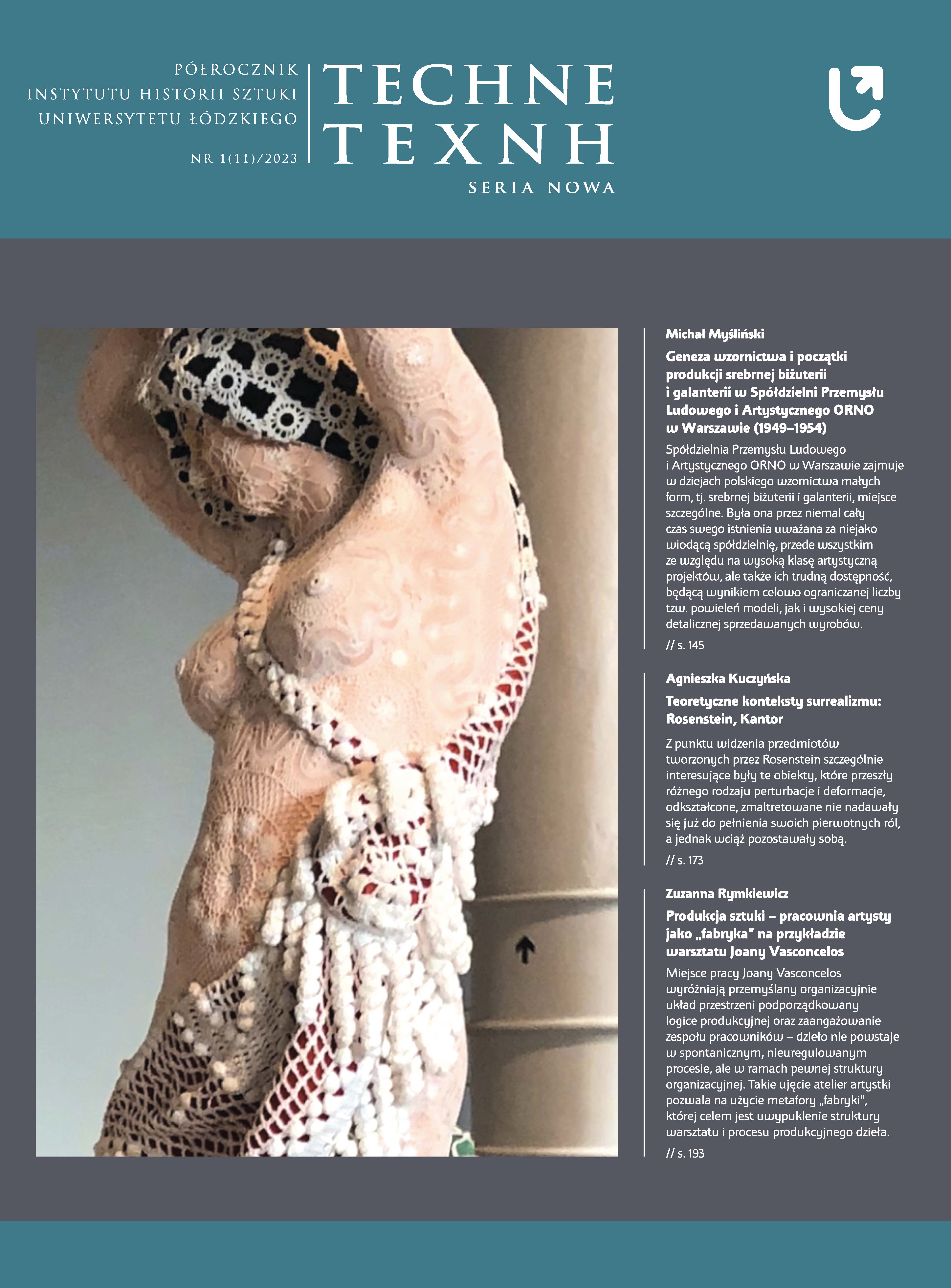Remiksowanie iluzji. Krzysztofa Wieczorka droga od grafiki do malarstwa
DOI:
https://doi.org/10.18778/2084-851X.15.14Słowa kluczowe:
Krzysztof Wieczorek, grafika warsztatowa, matryca, remiksowanieAbstrakt
Krzysztof Wieczorek, zmarły w 2021 roku łódzki artysta, był wybitnym grafikiem. W swoich poszukiwaniach twórczych ujawniał naturę dociekliwego współczesnego manierysty. W swoich pracach poddawał „obróbce” między innymi cytaty z obrazów i grafik Herculesa Seghersa. Fragmenty krajobrazów stworzonych przez holenderskiego twórcę uzupełniały pejzaże zakomponowane przez polskiego artystę.
Wieczorek dopełniał obraz dzięki różnym, graficznym i malarskim, ingerencjom. Zabiegi te zmierzały ku zróżnicowaniu odbitek z nakładu, dzięki czemu nabierały one charakteru unikatowego. Krzysztof Wieczorek wykorzystywał w swojej pracy wykonane wcześniej matryce, także ich fragmenty, zestawiając je w rozmaitych konfiguracjach. Możemy tu mówić o swoistym „remiksowaniu” artystycznych komunikatów. Wieczorek tworzył warianty obrazów, a nawet ich sekwencje. Sukcesywne modyfikowanie podłoża graficznego dokonywało się w dużej mierze poprzez złożone działania o charakterze malarskim.
W dziełach Wieczorka podkład stanowi zarówno jednorodna odbitka graficzna, jak i ich kolaż. Części składowe mogły być wykonane w akwaforcie, akwatincie, mezzotincie, suchej igle, czy pochodzić z wydruku komputerowego. Wybór techniki (lub technik), stopień destrukcji matrycy (dokonujący się na przykład poprzez chropowacenie, rytowanie i trawienie powierzchni) determinował do pewnego stopnia dalsze poczynania twórcy. Podobnie jak wykorzystanie kolorowych papierów do druku. Artysta eksperymentował także z podłożem, wykorzystując do swoich kompozycji powierzchnie płócienne, tekturowe czy drewniane. Podkład graficzny był poddawany zabiegom malarskim. Twórca kładł na powierzchni grafiki warstwę farby akwarelowej, olejnej czy akrylowej. Impregnował powierzchnie werniksami.
Istota poszukiwań podejmowanych przez Krzysztofa Wieczorka kryje się oczywiście w zachowania równowagi pomiędzy aspektami technicznymi i technologicznymi, a walorami estetycznymi dzieła oraz wyznaczanymi przez elementy świata przedstawionego treściami. W swoich poszukiwaniach twórca odnosił się do skomplikowanych relacji między tym, co graficzne, a tym, co malarskie. Szukał uniwersalnego, integralnego języka komunikacji wizualnej.
Bibliografia
CATAFAL/OLIVA 2005 − Jordi Catafal, Clara Oliva, Techniki graficzne, Warszawa 2005.
Google Scholar
COHAN 1993 − Ch. Cohan, The Net of Irrationality: The Variant Matrix and the Tyranny of the Edition, „Contemporary Impressions” 1993, t. 1, nr 2, s. 9–11.
Google Scholar
KREJČA 1984 − Aleš Krejča, Techniki sztuk graficznych, Warszawa 1984.
Google Scholar
LEŚNIKOWSKI 2006 – Dariusz Leśnikowski, Czytanie sztuki. Postawy – Interpretacje, Łódź 2006, s. 87–89
Google Scholar
LEŚNIKOWSKI 2016 – Dariusz Leśnikowski, Czytanie sztuki. Postawy – Interpretacje. Dekada druga, Łódź 2016, s. 87–89.
Google Scholar
WIECZOREK 2018 − Krzysztof Wieczorek, Warsztatowa grafika unikatowa, Łódź 2018.
Google Scholar
ZIMNA 2015 – Katarzyna Zimna, Autographic: Play with the graphic medium in a post-print age (publikacja pokonferencyjna), „Impact 9” International Multi-Disciplinary Printmaking Conference, Hangzhou, China Academy of Art, 2015.
Google Scholar
Krzysztof Wieczorek, Obrazy, Amcor Rentsch Galeria, Łódź 2004.
Google Scholar
Krzysztof Wieczorek, Grafiki z cyklu Więzy, mosty, granice, Miejska Galeria Sztuki, Łódź 2006.
Google Scholar
Pobrania
Opublikowane
Jak cytować
Numer
Dział
Licencja

Utwór dostępny jest na licencji Creative Commons Uznanie autorstwa – Użycie niekomercyjne – Bez utworów zależnych 4.0 Międzynarodowe.








